Is your toddler suddenly refusing to nap? Are you unsure if it’s just a phase or a sign they’re growing out of daytime sleep? Do you worry they might not be getting enough rest to stay healthy, focused, and emotionally balanced? Have you asked yourself, When do kids stop napping, and how can I support this transition without disrupting their development? What if your child still seems tired, but resists naps?
Most children stop napping between the ages of 3 and 5, but every child is different. Understanding when kids stop napping can help you adapt your daily routines to support their growth. Napping plays a vital role in memory retention, emotional regulation, and brain development, especially in preschoolers. Transitioning too soon may lead to crankiness and poor learning performance.
Figuring out nap needs can be confusing, especially when every child behaves differently. By understanding the signs, benefits, and challenges of dropping naps, we can better support healthy routines at home, in daycares, and kindergartens.
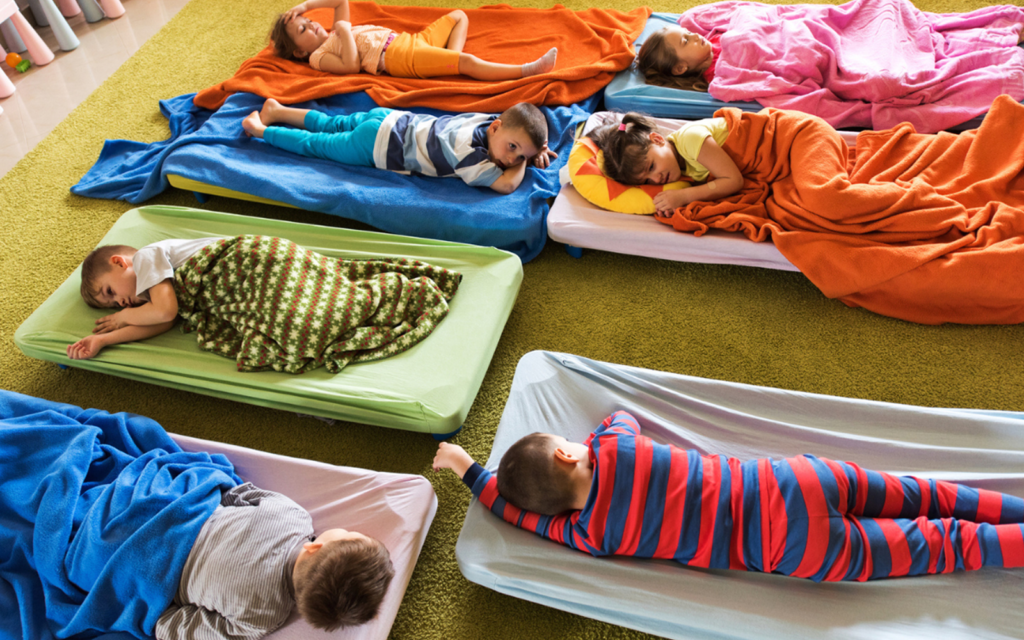
Why Do Kids Need Naps?
Naps aren’t just a break from activity—they are a foundational part of a child’s cognitive, emotional, and physical development. Whether you’re a parent or a kindergarten director, understanding why kids need naps will help you make better decisions around scheduling, environment design, and classroom expectations.
Children under six are still developing their neurological and biological systems. Their brains are highly active, constantly absorbing new information and forming new connections. This developmental process is exhausting, and naps offer a powerful tool to support these growing minds.
Learning and Memory
One of the most well-documented benefits of napping is its direct impact on memory consolidation. When a child learns something new—whether it’s a word, a social rule, or a physical task—those memories are temporarily stored in a part of the brain called the hippocampus. During sleep, especially during naps, the brain transfers this information to the neocortex for long-term storage. Without naps, children often forget or fail to integrate the new knowledge they’ve acquired during the day.
Research has shown that preschoolers who nap after learning tasks perform significantly better in recall exercises than those who stay awake. For kindergartens, this means nap time isn’t wasted time—it’s essential to reinforcing what’s taught in the classroom. It makes our job as preschool furniture suppliers even more critical, as we provide the comfortable, safe environments where these naps can happen.
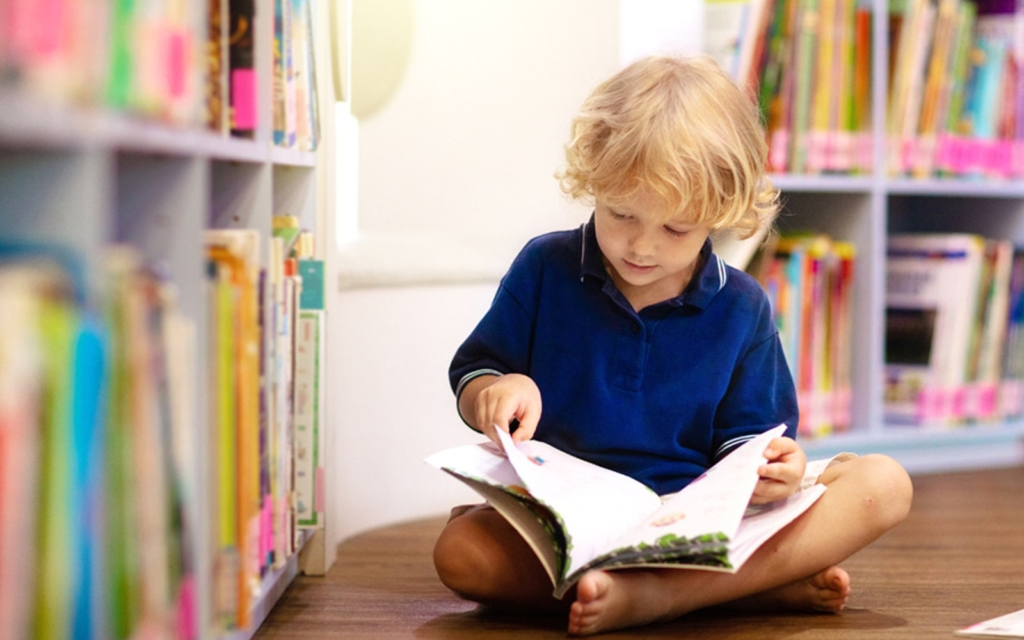
Attention
Another crucial benefit of naps is their effect on attention span. Children who skip naps tend to be more distracted, impulsive, and prone to behavioral issues. This isn’t simply about being “tired”—the prefrontal cortex, which controls attention and impulse regulation, is under immense strain without sufficient rest.
In well-rested children, teachers and caregivers often report greater engagement, better listening, and more consistent participation. That’s especially important in Montessori and Reggio environments, where independent learning and focus are key. Supporting nap times in these settings can be the difference between a calm, enriching day and a chaotic one. Naps help regulate the mental and emotional fatigue that accumulates through daily interaction, problem-solving, and new sensory experiences.

Receive a free catalog and custom layout to help you design your ideal classroom easily.
Mood
A well-timed nap can also dramatically improve a child’s emotional regulation. When children are overtired, their ability to manage frustration, anger, and disappointment is reduced. This often manifests as meltdowns, tantrums, or withdrawal—all of which can derail learning and social experiences.
Naps help children “reset” their emotional balance. After rest, they are more likely to approach challenges with curiosity rather than resistance. This is not only beneficial to the individual child but also improves classroom harmony. In our experience working with kindergartens across North America and Europe, classrooms with structured nap routines tend to experience fewer behavioral problems overall.
Motor Skills and Resiliency
Although often overlooked, napping also supports the development of motor skills. Fine and gross motor learning—such as holding a pencil, stacking blocks, or climbing outdoor play structures—requires both physical and neurological integration. Sleep enhances this process by allowing the body and brain to recover, reset, and process these tasks.
Moreover, children who nap regularly display greater resiliency. They recover faster from setbacks, persist longer with challenges, and bounce back emotionally after failure. Resiliency is one of the most valuable traits we can nurture in a child, especially in a fast-paced, highly stimulating learning environment.
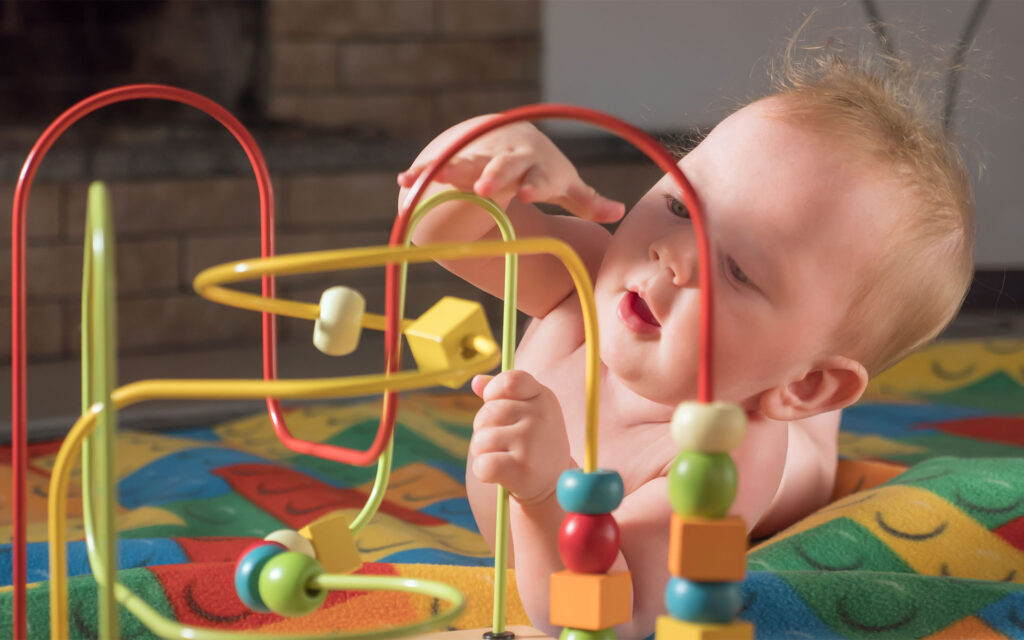
How Much Sleep Do Toddlers Need?
Sleep plays a crucial role in a toddler’s growth and daily function. Many parents and kindergarten operators often ask the same question: how much sleep do toddlers need to stay healthy and focused throughout the day?
Recommended Sleep Duration by Age
Toddlers between the ages of 1 and 3 typically need 11 to 14 hours of sleep every 24 hours. This total includes both nighttime sleep and one or two daytime naps. Children closer to 1 year old usually take two naps a day, while those approaching 3 often shift to one longer nap.
These hours are not just numbers—they directly affect a child’s behavior and learning. Without enough rest, toddlers often become overly active, emotionally sensitive, or struggle with attention. That’s why kindergartens and daycare centers should schedule regular rest periods and provide an environment that supports healthy sleep.
| Rango de edad | Recommended Total Sleep (24 hrs) | Typical Nap Pattern | Napping Status |
|---|---|---|---|
| 0–6 months | 14–17 hours | 3–4 naps per day | Nap needed; start of the transition period |
| 6–12 months | 12–16 hours | 2–3 naps per day | Still crucial; beginning to consolidate |
| 1–2 years | 11–14 hours | 1–2 naps per day | Primary nap period |
| 2–3 years | 11–14 hours | 1 nap per day | Usually, no nap; quiet time is beneficial |
| 3–4 years | 10–13 hours | 1 nap or quiet time | Many start dropping naps |
| 4–5 years | 10–13 hours | May nap occasionally or not at all | Most children stop napping |
| 5–6 years | 9–12 hours | Usually no nap; quiet time beneficial | Naps are essential; frequent, irregular |

Receive a free catalog and custom layout to help you design your ideal classroom easily.
Designing Nap-Friendly Environments
Kindergarten environments should be designed with rest in mind. Soft textures, calm lighting, and quiet surroundings help toddlers feel secure enough to sleep. At TOP Montessoris, we design nap furniture that supports natural posture, provides comfort, and allows educators to manage space efficiently.
Well-designed nap areas don’t just make children more comfortable—they also make it easier for teachers to create a structured, peaceful routine. When toddlers know what to expect, they tend to rest better and behave better throughout the rest of the day.
When Do Kids Stop Napping?
One of the most common questions parents and early childhood educators ask is, When do kids stop napping? The truth is, there isn’t one fixed answer. Each child develops on their timeline, and while some children stop napping as early as age 3, others may still benefit from daytime rest well into age five or beyond.
Instead of looking at age, the key is to observe behavior, energy levels, and how sleep affects mood and learning. Dropping naps is a gradual process, and there are several clear signs that a child may be ready to transition. Let’s take a closer look at some of the indicators that naps may no longer be necessary.
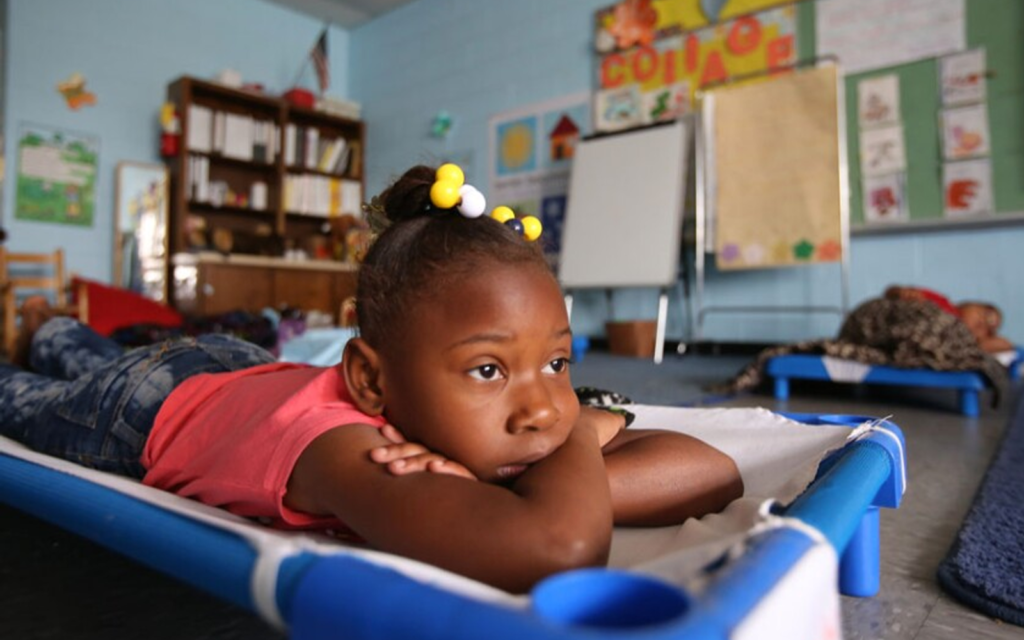
They Aren’t Fussy Before Naptime
Children who still need naps often show clear signs of fatigue by midday. This includes being irritable, overly emotional, clingy, or simply melting down more easily. These behaviors are the body’s natural way of signaling that rest is needed.
On the other hand, when a child consistently goes through the morning with stable emotions, consistent energy, and no noticeable dips in mood, they may no longer need to nap. If this pattern holds for several weeks, not just a day or two, they could be transitioning out of the nap phase.
It’s important to remember that occasional fussiness doesn’t mean a nap is still essential. What matters is the overall trend. When children show independence and emotional control throughout the day, they may be ready to go without midday sleep.
They Take Longer to Fall Asleep at Naptime
Another common sign is that a child begins taking longer and longer to fall asleep at nap time. What used to be a quick 10-minute process can stretch into 30 or 40 minutes of quiet restlessness. In many cases, they may not fall asleep at all.
This isn’t always defiance or resistance. Often, they are not tired. Their internal sleep needs have shifted, and forcing a nap may disrupt their natural rhythm. If falling asleep becomes a daily struggle, it may be time to consider cutting back on nap expectations.
It’s also essential to observe how the child behaves during this time. If they stay calm, engage quietly with a book or toy, and don’t seem distressed, it’s likely their body is adjusting and no longer needs the extra sleep.

They Take Longer to Fall Asleep at Night
A child who continues to nap but then struggles to fall asleep at night is often getting more sleep during the day than they need. If bedtime starts getting pushed later, and the child lies awake in bed for a long time despite a calm routine, that could mean the nap is interfering with nighttime rest.
Good sleep is not only about quantity, but also timing and consistency. When naps lead to late bedtimes, the overall quality of nighttime sleep can suffer. In many cases, children fall into a cycle where they nap because they went to bed too late, creating an ongoing loop that throws off their natural rhythm.
In these situations, shortening or removing the nap can help restore balance. After a brief adjustment period, many children fall asleep earlier and sleep more soundly through the night.
They Wake Up Earlier in the Morning
Sometimes the nap-to-night disruption shows up as early rising. A child who suddenly starts waking at 5:30 or 6:00 a.m. instead of their usual 7:00 might be sleeping too much during the day. Since young children tend to sleep for a relatively consistent total number of hours, adding a nap can reduce how long they sleep at night.
This pattern often goes unnoticed because early waking doesn’t always come with crankiness. But over time, it can lead to fragmented rest or daytime fatigue. If early morning wakeups become consistent and the child seems otherwise well-rested, removing the nap may help restore a more balanced schedule.

They Don’t Show Signs of Sleepiness on Days Without Naps
One of the most evident signs a child may no longer need naps is how they function on days without them. If a child skips a nap due to travel, an event, or a schedule change—and still manages the day without becoming overtired—it’s a good indication they’re adjusting.
Watch for patterns. A child who skips naps once or twice and melts down by dinner probably still needs them. But if they manage full days consistently without sleepiness or irritability, that’s a sign of increased maturity in their sleep cycle.
On these nap-free days, observe mood, attention span, physical energy, and behavior. Consistency is key. Occasional success isn’t enough to make a change, but stable patterns over time are.
They Are No Longer Napping at All
Eventually, some children stop napping on their own. Even when given the opportunity, they won’t fall asleep during rest time. They may still enjoy lying down or reading quietly, but sleep doesn’t come.
This usually happens after a gradual reduction in nap frequency—from every day, to every other day, to once or twice a week, and then finally none at all. At this point, forcing a nap isn’t helpful. Instead, quiet time becomes a healthy replacement.
Quiet time can involve books, soft music, puzzles, or solo play. It helps children recharge without requiring sleep. Even without naps, rest is still a valuable part of their daily rhythm.
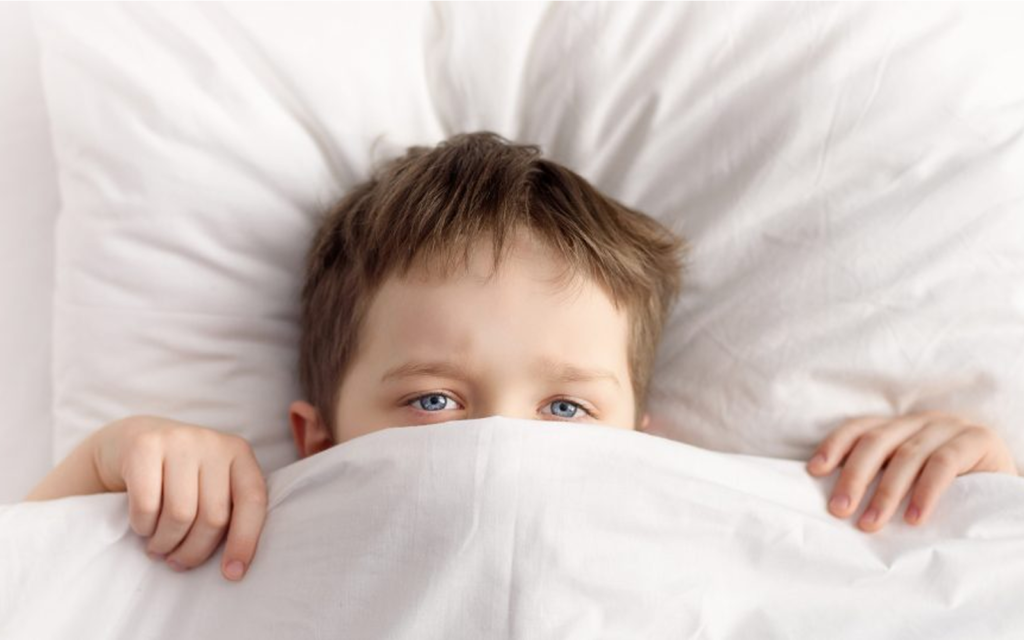
Best Nap Time Essentials for Toddlers in Kindergarten Settings
When Do Kids Stop Napping? The truth is—it varies. Some children begin dropping naps at three years old, while others need them until they’re five. But even during this transition period, nap time essentials remain incredibly important in any early childhood setting. So instead of asking just When Do Kids Stop Napping, we should also ask: How can we best support them during and after the transition?
That’s because nap time isn’t just about sleep. It’s about offering toddlers a structured, peaceful pause in the day where their bodies can rest and their minds can reset. Whether a child actually sleeps or simply lies down quietly, the nap environment plays a big role in supporting emotional regulation, sensory balance, and classroom behavior.
Child-Sized Nap Mats or Stackable Beds
Comfort and scale are everything. Toddlers need a space that fits their body, not oversized cots or loose floor mats that feel temporary or unstable. That’s why low-to-ground, stackable beds or thickly padded nap mats are ideal.
Even children nearing the stage when do kids stop napping benefit from having a defined rest space. It signals to the brain that this is a time for slowing down. When kids know what to expect, they settle more easily, whether they sleep or not.
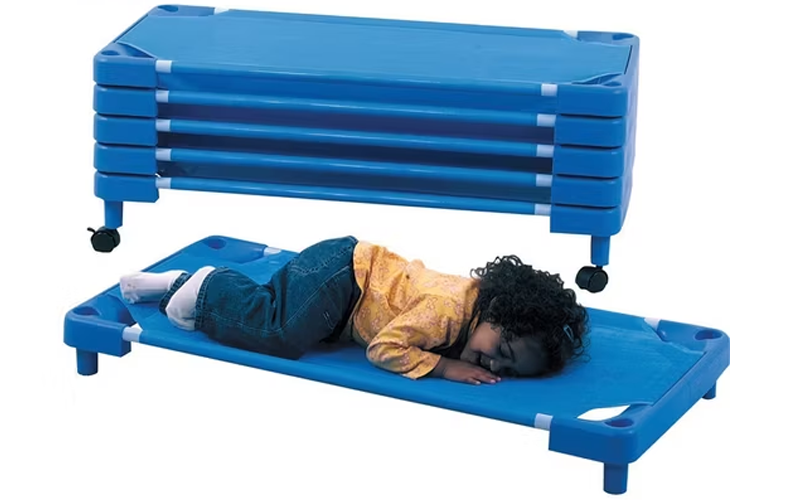
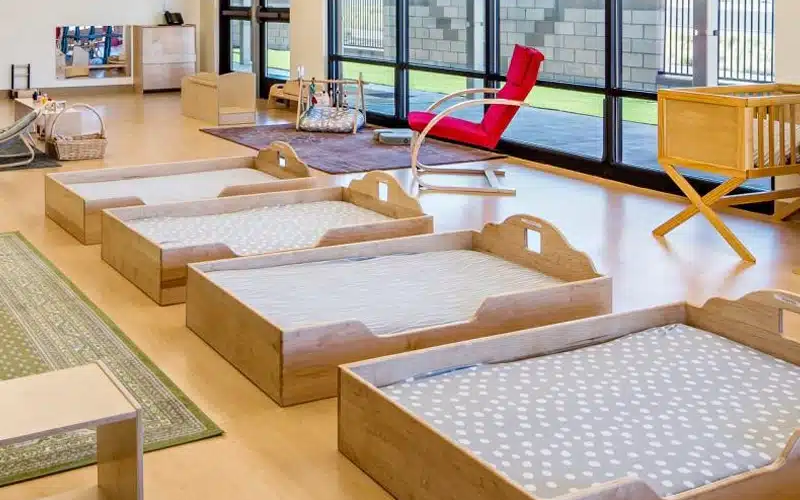
Soft Blankets and Breathable Sheets
Temperature control and tactile comfort affect how children relax. Light cotton sheets and fleece blankets offer security without overheating. For younger toddlers still regularly napping, soft bedding supports longer, deeper rest.
Even as children transition out of naps, offering a blanket to hold or cover their legs can help them feel more grounded during quiet time. This becomes a subtle tool for keeping children calm, especially in mixed-age classrooms where some nap and others don’t.


Low Lighting and Sound Management Tools
Lighting plays a subtle but powerful role in nap time success. Soft, dimmable lighting (like salt lamps or warm-toned LEDs) helps toddlers shift into rest mode naturally. Avoid fluorescent lighting, which tends to keep kids stimulated.
White noise machines or soft instrumental music can also be helpful, particularly in shared spaces. These tools block out background noise and create a predictable sensory environment, critical when children are on different sleep schedules.
Remember: When Do Kids Stop Napping isn’t always a clean-cut moment. Some children may nap every other day or only after particularly active mornings. A consistently calming environment supports all outcomes.
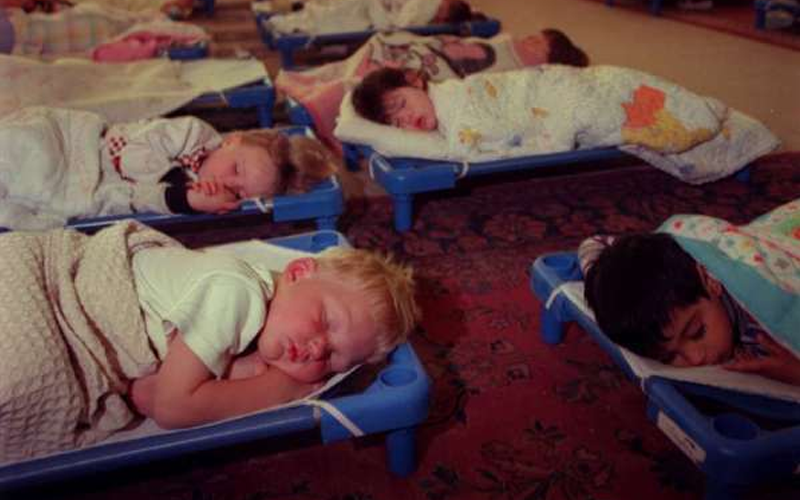
Cleanable Storage for Personal Sleep Items
Many children nap better when they use their blankets, soft toys, or sleep pillows. Providing dedicated storage (like cubbies or breathable fabric bags) for personal nap items ensures hygiene, comfort, and a sense of routine.
Children who are beginning to stop napping still benefit emotionally from having access to familiar rest-time belongings, even if they aren’t sleeping. A personal connection to nap time reinforces comfort and emotional safety.
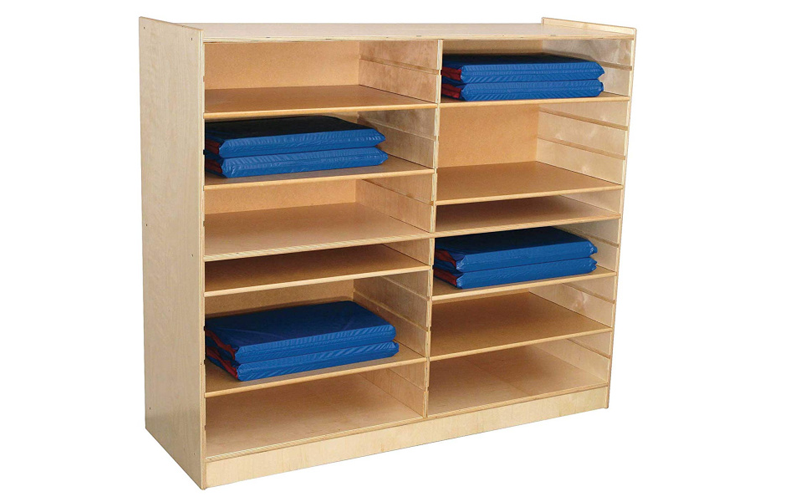


Receive a free catalog and custom layout to help you design your ideal classroom easily.
A Defined Rest Area—Even for Non-Nappers
One mistake I often see in early education centers is removing nap zones as soon as children begin outgrowing naps. This is a missed opportunity. Children who no longer nap still need a quiet, designated space to lie down, decompress, or enjoy soft activities like books or puzzles.
Quiet time is just as valuable as sleep, especially for kids in the grey zone between daily naps and full wakefulness. This is where the question When Do Kids Stop Napping becomes less about yes or no, and more about what kind of rest children still need during the day.
Design your classroom so there’s a clear boundary between active zones and rest areas. Even five-year-olds benefit from knowing there’s a place they can go to “pause” if needed.

Hygiene and Safety Considerations
Don’t overlook the importance of cleanable materials and safety-tested designs. Nap time involves close body contact with surfaces, so hypoallergenic materials, waterproof covers, and easy-to-disinfect features are a must.
Younger toddlers may still mouth fabrics or roll off beds, so anti-slip surfaces and rounded bed edges matter, especially when you’re dealing with group supervision. Regardless of when kids stop napping, the safety of the nap environment should never be compromised.

Receive a free catalog and custom layout to help you design your ideal classroom easily.
How Sleep Changes Without Naps?
One of the most significant shifts in early childhood development comes when children begin to outgrow daytime naps. Many parents ask not just When Do Kids Stop Napping, but also ” What happens to their sleep afterward? The transition doesn’t just affect the hours they sleep—it also changes how they sleep.
When naps are removed, the body’s entire sleep schedule adjusts. This includes bedtime, sleep quality, and even emotional behavior tied to rest. Understanding how sleep changes without naps can help families and educators support children during this key transition.
Earlier Bedtime Becomes Necessary
One of the most noticeable changes when a child stops napping is that they often need to go to bed earlier. Without that midday rest, their energy reserves deplete faster, and fatigue sets in sooner. A child who once went to bed at 8:30 or 9:00 p.m. may now need to start their bedtime routine by 6:30 or 7:00 p.m.
Missing this new sleep window can lead to overtiredness, which paradoxically makes it harder for children to fall asleep. Their bodies produce stress hormones when they’re exhausted, which can disrupt natural sleep patterns. Parents should watch for early signs of tiredness in the late afternoon and adjust bedtime accordingly.

Night Sleep Deepens
Another positive change is that nighttime sleep tends to become deeper and more consolidated when naps are no longer part of the day. Children often sleep more soundly through the night and experience fewer nighttime wakings. This is because the body’s sleep pressure builds steadily throughout the day, allowing for a more restorative sleep cycle once they lie down at night.
In this phase, total sleep duration may actually stay the same, just concentrated into one longer overnight period instead of being split between day and night.
Behavioral Patterns Shift
As the body adapts to no longer napping, children may initially show signs of moodiness, low energy, or shorter attention spans in the late afternoon. These reactions are common and temporary. The body’s internal clock, or circadian rhythm, slowly adjusts to the new routine, but it may take a few weeks.
During this period, keeping afternoons calm and predictable helps children transition smoothly. A brief quiet time—reading or soft activities—can act as a buffer, giving the child mental rest even if no sleep occurs.

Receive a free catalog and custom layout to help you design your ideal classroom easily.
Tips for the Naptime Transition
Once you start noticing the signs that your child may be ready to stop napping, the transition can feel uncertain. It’s not as simple as cutting naps overnight—children may need time to adjust physically, emotionally, and mentally. Some days they’ll still need a nap. Other days, they’ll push through just fine without one. For parents and caregivers, this inconsistency can be frustrating, especially when routines have already been set in place.
That’s why managing the transition out of naps requires flexibility, patience, and structure. Below are practical, tested strategies to help guide your child through this shift smoothly and confidently.
Turn Naptime into Quiet Time
One of the most effective approaches to the nap transition is to reframe naptime as quiet time. Just because a child no longer falls asleep doesn’t mean they don’t benefit from rest. Replacing the expectation of sleep with calm, independent activity helps maintain a restorative break in the middle of the day—something that’s especially useful for toddlers and preschoolers still developing their ability to regulate energy and emotion.
Quiet time can include reading, soft music, puzzles, or lying down with a stuffed animal. This time helps children decompress from the stimulation of the morning and reset before the afternoon. Even 20 to 30 minutes of low-stimulation time provides mental and emotional rest. It also reinforces the habit of daily downtime, which can be helpful even as children get older.
If a child occasionally falls asleep during quiet time, that’s fine too. This gentle, flexible approach allows for rest without creating power struggles around whether sleep must happen.
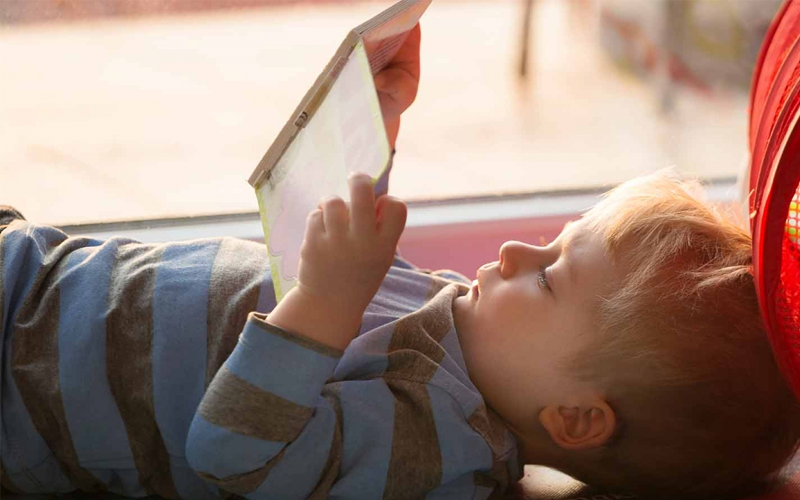
Expect Napping to Be Inconsistent at First
Many parents ask: When Do Kids Stop Napping altogether? The honest answer is that the process isn’t always clean or linear. Some children drop naps in stages. One day they’ll skip it entirely, then need one again the next. This can last for weeks—or even a few months.
It’s important to expect this inconsistency and avoid reacting to each skipped nap as if it were the new norm. On days when your child doesn’t nap, watch their mood in the late afternoon and evening. If they show signs of tiredness, that’s completely normal. Don’t assume a missed nap means naps are gone for good.
This unpredictable period is why keeping some form of downtime in the daily routine remains essential. Structure brings security during change. By offering a predictable rest window—even if sleep doesn’t occur—you help your child ease through the transition more comfortably.
Don’t Overschedule Your Afternoon
When children stop napping, it can be tempting to fill the extra time with activities or errands. But one common mistake is overloading the afternoon, assuming that without a nap, your child is ready for full-day stimulation. In reality, they may still be adjusting to the increased physical and emotional demands of staying awake all day.
Avoid back-to-back outings, overstimulating environments, or tightly packed schedules during the early days of the transition. Quiet afternoons at home, time in nature, or low-pressure activities are much better suited for this adjustment phase.
Preserving some slowness in the afternoon helps reduce the risk of late-day meltdowns, mainly as your child builds up stamina. Think of this as building endurance gradually, not expecting full-day performance from day one.

Consider an Earlier Bedtime
As naps phase out, your child’s total sleep still needs to stay within a healthy range. When kids Stop Napping, they may need to go to bed earlier in the evening to compensate for the lost daytime sleep. A child who previously went to bed at 8:00 p.m. may need to shift to 6:30 or 7:00 p.m. during the initial transition.
It’s common for children to become overtired quickly without naps, and overtiredness can make it harder for them to fall asleep. An earlier bedtime helps them fall asleep more easily and stay asleep longer, supporting their overall development and mood.
If you notice your child becoming overly cranky during dinner or falling asleep in the car on late-day drives, try moving bedtime earlier by 15 to 30 minutes. Adjust slowly and observe how they respond. Many families find this slight shift makes a big difference during nap transitions.
When Do Kids Still Need Naps?
While many parents focus on the question “When Do Kids Stop Napping?”, it’s just as important to understand when they still need them. Not all children transition out of naps at the same age. Some signs may look like natural growth, but they can also point to overtiredness. Knowing when naps are still essential can help prevent behavior issues and support healthy development.
The truth is, understanding when kids Stop Napping also means recognizing the signals that they shouldn’t stop just yet. Behavior offers more precise answers than the calendar.
Frequent Meltdowns and Emotional Outbursts
One of the strongest signs to answer the question When Do Kids Stop Napping is through their mood. If a child is having frequent meltdowns late in the day, it may mean they still need naps. Fatigue impacts emotional regulation, making even minor frustrations feel overwhelming.
Instead of assuming it’s a behavioral issue, consider whether these emotional outbursts follow napless days. In many cases, when Do Kids Stop Napping is answered by what happens when they don’t—more tears, more outbursts, and more stress.

Increased Silliness or Clumsiness
Another way to tell when kids Stop Napping is to observe their physical behavior. If a child becomes overly silly, hyperactive, or starts tripping, dropping things, or bumping into furniture more often, that can be a sign of tiredness, not energy.
These behaviors are often misunderstood. Parents may think their child isn’t tired because they’re “bouncing off the walls,” but in reality, this kind of uncontrolled energy is the body’s last-ditch attempt to stay awake. It’s a subtle but reliable answer to When Do Kids Stop Napping—they don’t, if this keeps happening.
Disinterest in Food
Changes in eating habits can also help clarify when kids Stop Napping. Fatigue suppresses hunger and affects digestion. If a child who usually eats well becomes suddenly disinterested in food, especially in the late afternoon, it might be due to overtiredness from skipping naps.
Look for patterns. If the child eats normally on days they nap but picks at food when they don’t, that’s a strong clue. In these cases, When Do Kids Stop Napping is still in the future—their body isn’t ready to function without rest.
Difficulty Focusing or Following Instructions
One of the most overlooked indicators of when kids Stop Napping is their attention span. Children who stop napping too early often struggle with focus. They may jump from task to task, forget instructions, or seem to “tune out” during conversations or activities.
This lack of concentration is not always a sign of misbehavior or disinterest—it’s often mental fatigue. When focus drops significantly in the absence of naps, it shows that When Do Kids Stop Napping is not yet. Their brain still needs that extra rest to function correctly.
So—When Do Kids Stop Napping? The answer depends on what their behavior tells you. If they’re frequently emotional, clumsy, distracted, or skipping meals, naps may still be crucial. Sleep supports learning, emotional control, and overall well-being.
Instead of asking if your child should stop napping because of age or peer comparisons, look at what their mind and body are showing you. Often, the best way to answer it is to realize when they’re not quite ready yet.
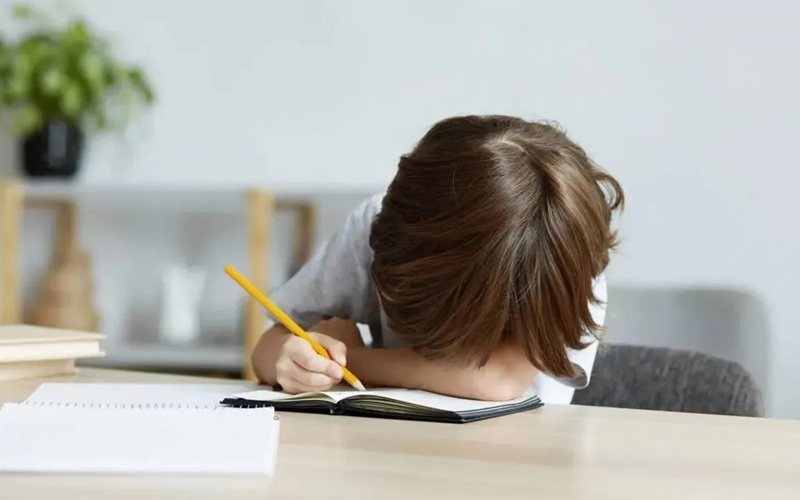

Receive a free catalog and custom layout to help you design your ideal classroom easily.
Preguntas frecuentes
1. How do I know when to remove naps in a kindergarten classroom?
The best time to reduce or remove naps is when a child consistently shows no signs of sleepiness, handles the afternoon without emotional outbursts, and maintains focus throughout the day. Observing these patterns over several weeks is more reliable than relying on age alone. Understanding when kids Stop Napping helps tailor classroom routines for both nappers and non-nappers.
2. Do all toddlers stop napping at the same age?
No. While some toddlers begin dropping naps around age 3, others may still benefit from napping until age 5 years old. Factors like activity level, sleep quality at night, and emotional development all affect when kids stop napping. There’s no universal timeline, which is why flexible nap setups are essential in kindergarten environments.
3. Can quiet time replace naps for toddlers who no longer sleep?
Yes. Quiet time is a valuable substitute when children are nearing the stage when Do Kids Stop Napping. It provides a period of mental rest and emotional reset, even if no sleep occurs. Activities like reading, lying down, or listening to calm music support self-regulation and reduce overstimulation during the school day.
4. What are the signs that a child still needs to nap?
Frequent late-day meltdowns, difficulty focusing, clumsiness, and disinterest in food can all signal that a child is not ready to give up naps. When evaluating when kids Stop Napping, these behavioral cues are more reliable than age or peer comparison.
5. How can nap time be managed in mixed-age classrooms?
Offer a designated nap zone with optional rest time. Provide soft bedding for younger children who nap regularly and a quiet activity area for older ones who are transitioning. Managing both groups effectively starts with understanding when kids Stop Napping and adapting space and supervision accordingly.
6. Does skipping naps affect nighttime sleep?
Yes, especially during the transition. Children who skip naps may become overtired, which can delay bedtime and reduce the quality of nighttime sleep. Parents and educators need to monitor sleep cycles carefully during the period When Kids Stop Napping, to ensure total daily rest remains adequate.
7. What nap essentials support toddlers during the transition period?
Key nap time essentials include comfortable, child-sized nap mats, soft blankets, sound machines, and dim lighting. These create a restful environment for those still napping and a calming space for others. These tools remain useful even beyond the stage When Do Kids Stop Napping.
8. Is it okay if a child naps some days and not others?
Absolutely. During the transition phase, it’s common for children to nap inconsistently. Some days their bodies need rest, while other days they can go without. This is a normal part of the developmental process and fits into the broader answer to When Do Kids Stop Napping—which is, gradually and differently for each child.
Conclusión
Understanding When Do Kids Stop Napping is not just about identifying an age—it’s about reading a child’s needs during a key developmental stage. Some toddlers may be ready to transition out of naps, while others still rely on daytime rest for emotional regulation and focus. The right nap time essentials—such as child-sized beds, calming environments, and flexible routines—support all children, whether they nap daily or are slowly growing out of the habit. By observing behavior and providing appropriate rest options, we can create balanced, responsive early learning environments where every child thrives, whether asleep or simply resting.







